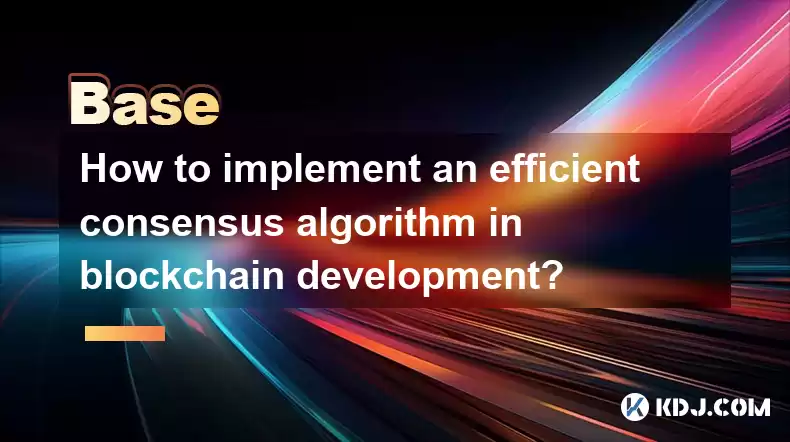-
 bitcoin
bitcoin $100977.009184 USD
-2.05% -
 ethereum
ethereum $3282.009150 USD
-3.23% -
 tether
tether $0.999813 USD
-0.02% -
 xrp
xrp $2.208254 USD
-4.89% -
 bnb
bnb $951.411089 USD
0.55% -
 solana
solana $155.761205 USD
-2.84% -
 usd-coin
usd-coin $1.000217 USD
0.02% -
 tron
tron $0.284475 USD
-1.28% -
 dogecoin
dogecoin $0.162363 USD
-1.53% -
 cardano
cardano $0.533988 USD
-0.47% -
 hyperliquid
hyperliquid $39.174339 USD
-3.22% -
 chainlink
chainlink $14.724828 USD
-1.16% -
 bitcoin-cash
bitcoin-cash $477.297986 USD
-1.28% -
 zcash
zcash $554.227426 USD
17.30% -
 ethena-usde
ethena-usde $0.998995 USD
-0.03%
How to implement an efficient consensus algorithm in blockchain development?
Efficient blockchain development requires careful selection of a consensus mechanism, balancing security, scalability, and energy consumption, and employing optimization techniques like sharding and layer-2 solutions to enhance performance.
Mar 07, 2025 at 09:24 am

- Understanding the trade-offs between different consensus mechanisms (Proof-of-Work, Proof-of-Stake, etc.) is crucial for efficient blockchain development.
- Choosing the right algorithm depends on the specific needs and priorities of the blockchain project (e.g., security, scalability, energy consumption).
- Efficient implementation requires careful consideration of data structures, network communication protocols, and cryptographic techniques.
- Optimization techniques, such as sharding and layer-2 scaling solutions, can significantly improve the performance of a blockchain network.
- Security considerations are paramount and must be addressed throughout the development process.
Choosing the right consensus mechanism is paramount in blockchain development. The efficiency of your blockchain hinges heavily on this decision. Different algorithms offer varying levels of security, scalability, and energy consumption. Understanding these trade-offs is essential before beginning implementation.
Proof-of-Work (PoW), popularized by Bitcoin, prioritizes security through computationally intensive mining. However, its high energy consumption and scalability limitations are well-documented. Ethereum's transition to Proof-of-Stake (PoS) exemplifies a shift towards more energy-efficient alternatives.
Proof-of-Stake (PoS) requires validators to stake their cryptocurrency to participate in consensus. This significantly reduces energy consumption compared to PoW. However, PoS systems can be susceptible to attacks if not carefully designed and implemented, particularly 51% attacks. Delegated Proof-of-Stake (DPoS) addresses some of these concerns by allowing token holders to delegate their voting rights to elected representatives.
Other consensus mechanisms exist, including Practical Byzantine Fault Tolerance (PBFT), which is well-suited for smaller, private blockchains. It offers high throughput and low latency but struggles with scalability in larger networks. Hybrid approaches combining elements of different consensus mechanisms are also being explored to leverage the strengths of each.
Efficient implementation goes beyond algorithm selection. Data structures play a crucial role. Using efficient data structures, such as Merkle trees for data verification, minimizes storage and computational overhead. Network communication is equally important. A well-designed network protocol minimizes latency and maximizes throughput. Careful consideration of network topology and communication protocols is crucial for efficient consensus.
Cryptographic techniques underpin the security and integrity of any blockchain. Choosing secure and efficient cryptographic algorithms is vital. The selection should consider factors like computational cost, security strength, and resistance to known attacks. Regular security audits are essential to identify and address vulnerabilities.
Optimization Techniques:Several techniques can significantly enhance the efficiency of a blockchain network.
- Sharding: This technique partitions the blockchain into smaller, more manageable shards, allowing for parallel processing of transactions. This improves scalability and throughput significantly.
- Layer-2 Scaling Solutions: These solutions process transactions off-chain, reducing the load on the main blockchain. Examples include state channels, sidechains, and rollups. These solutions offer scalability without compromising the security of the main chain.
- Optimized Data Structures: Using efficient data structures like Merkle trees and Bloom filters can drastically reduce storage and computational requirements.
- Efficient Consensus Protocols: Careful implementation and optimization of the chosen consensus algorithm are critical. This includes minimizing communication overhead and optimizing cryptographic operations.
Implementing a consensus algorithm involves several steps:
- Design and Specification: Clearly define the requirements, including security, scalability, and energy efficiency goals. Choose a suitable consensus algorithm.
- Protocol Implementation: Develop the network protocol for communication between nodes. This includes message formats and handling mechanisms.
- Data Structure Implementation: Implement efficient data structures like Merkle trees and hash tables for data storage and verification.
- Cryptography Integration: Integrate secure cryptographic primitives for digital signatures, hashing, and encryption.
- Testing and Validation: Thoroughly test the implementation to ensure correctness, security, and efficiency.
Security is paramount. A poorly secured blockchain is vulnerable to various attacks.
- 51% Attacks: These attacks occur when a single entity controls more than 50% of the network's hashing power (PoW) or stake (PoS). Mitigation strategies involve designing robust consensus protocols and mechanisms to deter malicious actors.
- Sybil Attacks: These involve creating multiple fake identities to gain undue influence on the network. Solutions include reputation systems and identity verification mechanisms.
- Double-Spending Attacks: These involve spending the same cryptocurrency twice. Strong consensus mechanisms and efficient transaction validation prevent these attacks.
- Smart Contract Vulnerabilities: If the blockchain utilizes smart contracts, securing them against vulnerabilities is crucial. Regular audits and rigorous testing are essential.
A: There is no single "most efficient" algorithm. The best choice depends on the specific needs of the blockchain project, balancing security, scalability, and energy consumption. PoS generally offers better energy efficiency than PoW, but PoW might be preferred for its established security track record in some contexts.
Q: How can I improve the throughput of my blockchain?A: Implement sharding, layer-2 scaling solutions, optimize data structures, and carefully tune the consensus algorithm. Network optimization and efficient communication protocols are also crucial.
Q: What are the security risks associated with implementing a consensus algorithm?A: The major risks include 51% attacks, Sybil attacks, double-spending attacks, and vulnerabilities in smart contracts (if applicable). Robust design, rigorous testing, and regular security audits are essential to mitigate these risks.
Q: What programming languages are best suited for blockchain development?A: Many languages are used, including but not limited to: Solidity (for Ethereum smart contracts), Go (for high-performance applications), Rust (for its memory safety), and C++ (for its performance and control). The choice often depends on the specific needs of the project and the developer's expertise.
Disclaimer:info@kdj.com
The information provided is not trading advice. kdj.com does not assume any responsibility for any investments made based on the information provided in this article. Cryptocurrencies are highly volatile and it is highly recommended that you invest with caution after thorough research!
If you believe that the content used on this website infringes your copyright, please contact us immediately (info@kdj.com) and we will delete it promptly.
- Vande Mataram at 150: Stamps, Coins, and a Year-Long Celebration
- 2025-11-07 14:45:01
- Pi Network: Alignment, Not Just Speed, Is the Future of Crypto
- 2025-11-07 13:00:02
- Pi Network: Life Changes and a New Era Dawns for Crypto Pioneers
- 2025-11-07 13:00:02
- Bonhams Hong Kong: Rare Watches Echo Through Time
- 2025-11-07 12:35:01
- Unverified Apps, PiCoin, and a Costly Lesson: Navigating the Wild West of Crypto
- 2025-11-07 13:05:01
- Fed Governors, FOMC, and Interest Rates: Navigating the Shifting Landscape
- 2025-11-07 13:05:01
Related knowledge

What is FUD (Fear, Uncertainty, and Doubt) and how does it impact the market?
Nov 07,2025 at 02:19pm
Understanding FUD in the Cryptocurrency Ecosystem1. FUD stands for Fear, Uncertainty, and Doubt, a psychological tactic used to influence perception a...

What is a "rug pull" and how can you spot the warning signs?
Nov 07,2025 at 02:39pm
Understanding Market Volatility in the Crypto Space1. Cryptocurrency markets are known for their extreme price fluctuations, often driven by speculati...

How does a crypto transaction get confirmed on the network?
Nov 07,2025 at 12:40pm
Understanding the Journey of a Cryptocurrency Transaction1. When a user initiates a cryptocurrency transaction, it is broadcasted to the network throu...

What is the Ethereum Virtual Machine (EVM) and why is it important?
Nov 07,2025 at 03:59pm
Understanding the Ethereum Virtual Machine (EVM)1. The Ethereum Virtual Machine (EVM) is a decentralized runtime environment that executes smart contr...

What is yield farming and how can you generate income with it?
Nov 07,2025 at 01:39pm
What Is Yield Farming in the Cryptocurrency Space?1. Yield farming is a method used by cryptocurrency holders to generate returns on their digital ass...

What is a crypto airdrop and how can you participate in one?
Nov 07,2025 at 11:20am
What Is a Crypto Airdrop?1. A crypto airdrop is a marketing strategy used by blockchain projects to distribute free tokens or coins to wallet addresse...

What is FUD (Fear, Uncertainty, and Doubt) and how does it impact the market?
Nov 07,2025 at 02:19pm
Understanding FUD in the Cryptocurrency Ecosystem1. FUD stands for Fear, Uncertainty, and Doubt, a psychological tactic used to influence perception a...

What is a "rug pull" and how can you spot the warning signs?
Nov 07,2025 at 02:39pm
Understanding Market Volatility in the Crypto Space1. Cryptocurrency markets are known for their extreme price fluctuations, often driven by speculati...

How does a crypto transaction get confirmed on the network?
Nov 07,2025 at 12:40pm
Understanding the Journey of a Cryptocurrency Transaction1. When a user initiates a cryptocurrency transaction, it is broadcasted to the network throu...

What is the Ethereum Virtual Machine (EVM) and why is it important?
Nov 07,2025 at 03:59pm
Understanding the Ethereum Virtual Machine (EVM)1. The Ethereum Virtual Machine (EVM) is a decentralized runtime environment that executes smart contr...

What is yield farming and how can you generate income with it?
Nov 07,2025 at 01:39pm
What Is Yield Farming in the Cryptocurrency Space?1. Yield farming is a method used by cryptocurrency holders to generate returns on their digital ass...

What is a crypto airdrop and how can you participate in one?
Nov 07,2025 at 11:20am
What Is a Crypto Airdrop?1. A crypto airdrop is a marketing strategy used by blockchain projects to distribute free tokens or coins to wallet addresse...
See all articles










































































